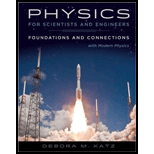
Concept explainers
Often we have distributions of charge for which integrating to find the electric field may not be possible in practice. In such cases, we may be able to get a good approximate solution by dividing the distribution into small but finite particles and taking the vector sum of the contributions of each. To see how this might work, consider a very thin rod of length L = 16 cm with uniform linear charge density λ = 50.0 nC/m. Estimate the magnitude of the electric field at a point P a distance d = 8.0 cm from the end of the rod by dividing it into n segments of equal length as illustrated in Figure P24.21 for n = 4. Treat each segment as a particle whose distance from point P is measured from its center. Find estimates of EP for n = 1, 2, 4, and 8 segments.

FIGURE P24.21
The magnitudes of electric fields at P for the segments
Answer to Problem 21PQ
The magnitude of electric fields
Explanation of Solution
Write the expression to calculate the electric field.
Here,
Write the expression to calculate the charge in each segment.
Here,
Substitute the above equation in the expression for
Write the expression to calculate
Here, d is the distance of the point P from the end of the rod.
Write the expression to calculate
Write the expression to calculate
Write the expression to calculate
Substitute the equations (II), (III), (IV) and (V) in (I) to rewrite.
Conclusion:
Substitute
Similarly, by following the same concepts the electric field for
Therefore, the magnitude of electric fields
Want to see more full solutions like this?
Chapter 24 Solutions
Physics For Scientists And Engineers: Foundations And Connections, Extended Version With Modern Physics
- help and explain how to find the answerarrow_forwardWhat is the equivalent resistance between points A and B of the network shown in the figure? A • 12 B 4.0 6.0 Ω 8.0 Ωarrow_forwardAccording to the provided information answer the question accorrding to grade 11 physics Jerry has decided to give up his part-time job for a new career, cat-burglar! Jerry loves the idea of dressing up like a cat all day and of course the chance of meeting Cat Woman! On Jerry's first "job" he figures out his escape plan. He travels 3.0 km south for 15 minutes and then 8.0 km west for 1.5 hours before reaching his house. Draw a sketch diagram of the path he took with all the appropriate labels.arrow_forward
 Physics for Scientists and Engineers: Foundations...PhysicsISBN:9781133939146Author:Katz, Debora M.Publisher:Cengage Learning
Physics for Scientists and Engineers: Foundations...PhysicsISBN:9781133939146Author:Katz, Debora M.Publisher:Cengage Learning College PhysicsPhysicsISBN:9781938168000Author:Paul Peter Urone, Roger HinrichsPublisher:OpenStax College
College PhysicsPhysicsISBN:9781938168000Author:Paul Peter Urone, Roger HinrichsPublisher:OpenStax College Principles of Physics: A Calculus-Based TextPhysicsISBN:9781133104261Author:Raymond A. Serway, John W. JewettPublisher:Cengage Learning
Principles of Physics: A Calculus-Based TextPhysicsISBN:9781133104261Author:Raymond A. Serway, John W. JewettPublisher:Cengage Learning College PhysicsPhysicsISBN:9781305952300Author:Raymond A. Serway, Chris VuillePublisher:Cengage Learning
College PhysicsPhysicsISBN:9781305952300Author:Raymond A. Serway, Chris VuillePublisher:Cengage Learning
 Physics for Scientists and Engineers, Technology ...PhysicsISBN:9781305116399Author:Raymond A. Serway, John W. JewettPublisher:Cengage Learning
Physics for Scientists and Engineers, Technology ...PhysicsISBN:9781305116399Author:Raymond A. Serway, John W. JewettPublisher:Cengage Learning





